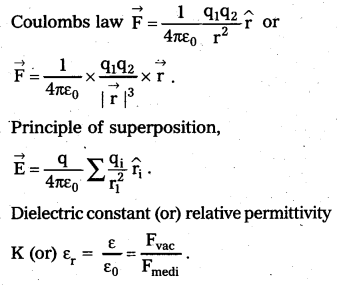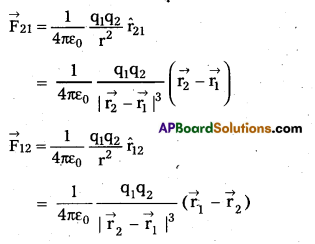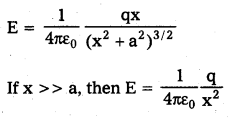Students can go through AP Inter 2nd Year Physics Notes 4th Lesson Electric Charges and Fields will help students in revising the entire concepts quickly.
AP Inter 2nd Year Physics Notes 4th Lesson Electric Charges and Fields
→ If the sizes of charged bodies are very small as compared to the distances between them, are called point charges.
→ Quantisation of electric charge means that total charge (q) of a body is always an integral multiple of a basic quantum of charge (e) i.e., Q = ne, where n = 0, ±1, ±2, +3.
→ Coulomb’s law gives us the force acting between two stationary charges placed at a given distance. It is called inverse square law as the electrostatic force is inversely proportional to the square of the distance between the charges. Coulombs law in SI in medium is, F = \(\frac{1}{4 \pi \varepsilon} \cdot \frac{\mathrm{q}_1 \mathrm{q}_2}{\mathrm{r}^2}\), where e is the permittivity of the medium.
→ Dielectric constant of the medium, K = \(\frac{\varepsilon}{\varepsilon_0}\).
→ The superposition principle is based on the fact that the electrostatic force between any two charges is not affected by the presence of other charges.
![]()
→ Electric field intensity at a point is the force experienced per unit positive test charge at that point.
→ A line of force is a curve, the tangent to which at any point gives the direction of electric field at that point. Electrostatic lines of force are not closed curves.
→ Electric flux, ΦE = \(\int_S\) E. dS. Area of an element dS is also a vector and is directed along the outward drawn normal to the area. Electric flux is a scalar quantity.
→ Gauss’s law states that the total electric flux through any closed surface is equal to \(\frac{1}{\varepsilon_0}\) times the total charge enclosed by the surface.
ΦE = \(\oint_S \mathrm{E} \cdot \mathrm{dS}=\frac{\mathrm{q}}{\varepsilon_0}\)
→ Work done per unit positive test charge in bringing it from infinity to a point against the electrostatic force is the potential (V) at that point. It is a scalar quantity.
→ Electric field E due to a point charge ‘q’ at a distance ‘r’ in free space E = \(\frac{1}{4 \pi \varepsilon_0} \cdot \frac{\mathrm{q}}{\mathrm{r}^2}\)
Electric potential V due to a charge ‘q’ at a distance ‘r’ in free space = V = \(\frac{1}{4 \pi \varepsilon_0} \cdot \frac{q}{r}\)
→ A pair of equal and opposite point charges q and -q, separated by a distance 2a is called an electric dipole.
→ In non-polar molecules, the centres of position charges and of negative charges coincides their dipole moment is zero.
E.g.: CO2, CH4.
→ In polar molecules, the centres of positive charges and of negative charges do not coincide, they have a permanent dipole moment.
E.g.: H2>O.
![]()
→ Charge per unit surface area of a body is called charge density, σ = \(\frac{\Delta Q}{\Delta S}\).
→ Charge per unit length of a wire is called linear charge density, λ = \(\frac{\Delta Q}{\Delta l}\).
→ Charge per unit volume of a body is called volume charge density ρ = \(\frac{\Delta Q}{\Delta V}\)
→ Field due to an infinitely long straight uniformly charged wire, E = \(\frac{\lambda}{2 \pi \varepsilon_0 r}\)
→ Field due to a uniformly charged infinite plane sheet E, = \(\frac{\sigma}{2 \varepsilon_0}\).
→ Thin spherical shell of uniform surface charge density σ,
(i) E = \(\frac{\mathrm{q}}{4 \pi \varepsilon_0 \mathrm{r}^2}\) (≥ R) (ii) E = 0 (r < R). → Field of an electric dipole in its equatorial plane at a distance r from the centre, E = \(\frac{p}{4 \pi \varepsilon_0} \frac{1}{\left(a^2+r^2\right)^{3 / 2}}\) E = \(\frac{p}{4 \pi \varepsilon_0 r^3} \text { for } r>>a\)
→ Dipole electnc field on the axis at a distance r from the centre E = \(\frac{2 {Pr}}{4 \pi \varepsilon_0\left(r^2-a^2\right)^2} \cong \frac{2 \mathrm{P}}{4 \pi \varepsilon_0 r^3}\) for r > > a.
→ In uniform electric field E, a dipole experiences a torque t, given by τ = P × E.
Formulae

→ Coulomb’s law in vector form is

→ Electric field intensity at any point on the axis of a uniformly charged ring is

→ Electric dipole moment is \(\overrightarrow{\mathrm{P}}_{\mathrm{e}}=\mathrm{q}(2 \overrightarrow{\mathrm{a}})\)
→ Intensity of electric field
- axial line, it is \(\overrightarrow{\mathrm{E}}_{\mathrm{a}}=\frac{2 \overrightarrow{\mathrm{p}} \cdot \mathrm{r}}{4 \pi \varepsilon_0\left(\mathrm{r}^2-\mathrm{a}^2\right)^2}\)
- on equitorial line or Neutral axis, it is \(\overrightarrow{\mathrm{E}}_{\mathrm{eq}}=\frac{\overrightarrow{\mathrm{P}}}{4 \pi \varepsilon_0\left(\mathrm{r}^2-\mathrm{a}^2\right)^{3 / 2}}\)
![]()
→ Torque on an electric dipole placed in a uniform electric field τ = PE sin θ
In vector form \(\vec{\tau}=\overrightarrow{\mathrm{P}} \times \overrightarrow{\mathrm{E}}\), if \(\overrightarrow{\mathrm{E}}\) is uniform.
→ Potential energy of an electric dipole in uniform electric field is
U = -PE cos θ = \(-\overrightarrow{\mathrm{P}} \cdot \overrightarrow{\mathrm{E}}\)
→ Gausses theorem is \(\oint \vec{E} \cdot d \vec{s}=\frac{q}{\varepsilon_0}\)
→ Electric field intensity at any point
- due to a line charge E = \(\frac{1}{2 \pi \varepsilon_0} \cdot \frac{\lambda}{\mathrm{r}}\)
- due to an infinite sheet of charge of density, E = \(\frac{\sigma}{2 \varepsilon_0}\)
- due to an infinite plane conductor having finite thickness, E = \(\frac{\sigma}{\varepsilon_0}\)
→ Electric field intensity due to two infinite parallel sheet of charges.
- In the region between the sheets
E = \(\frac{1}{2 \varepsilon_0}\left(\sigma_{\mathrm{A}}-\sigma_{\mathrm{B}}\right)\) - In the region outside the sheets
E = \(\frac{1}{2 \varepsilon_0}\left(\sigma_{\mathrm{A}}+\sigma_{\mathrm{B}}\right)\)
→ Electric field due to a charged spherical shell
- When point of observation lies inside the shell E = 0
- When point of observation lies outside the shell E = \(\frac{1}{4 \pi \varepsilon_0} \cdot \frac{q}{r^2}\)
- On the surface of the shell E = \(\frac{1}{4 \pi \varepsilon_0} \cdot \frac{q}{r^2}\)
→ Electric field due to a charged sphere
- outside the charged sphere
E = \(\frac{1}{4 \pi \varepsilon_0} \cdot \frac{\mathrm{q}}{\mathrm{r}^2}=\frac{\rho}{\varepsilon_0} \cdot \frac{\mathrm{R}^3}{\mathrm{r}^2}\) - On the surface of the charged sphere
E = \(\frac{1}{4 \pi \varepsilon_0} \cdot \frac{\mathrm{q}}{\mathrm{R}^2}=\frac{\rho \mathrm{R}}{3 \varepsilon_0}\) - Inside the sphere
E = \(\frac{1}{4 \pi \varepsilon_0} \cdot \frac{\mathrm{qr}}{\mathrm{R}^3}=\frac{\rho \mathrm{r}}{3 \varepsilon_0}\)